Application of Bias Correction to Improve WRF Ensemble Wind Speed Forecast
Abstract
1. Introduction
2. Methods
2.1. Decaying Average Algorithm
2.2. Probability Matching Mean (PMM)
3. Materials and Experimental Design
3.1. Materials
3.2. Experimental Design
- c = 153 cases; t = 0~72 h; m = 1,24;
- m = 1~20: for 20 members;
- m = 21: the ensemble mean;
- m = 22: the mean of members using YSU PBL;
- m = 23: the mean of members using MYNN2 PBL;
- m = 24: the mean of members using MYJ PBL.
4. Results
4.1. Verification of the Original Ensemble Forecast (oEPS)
4.2. Verification of the Three Calibrated Ensemble Forecasts
4.3. Verification of Probability Matched Mean (PMM) Products
5. Discussion and Conclusion
- (a)
- BC01: System bias from a single model error of the original ensemble mean.
- (b)
- BC03: System bias was represented by three model errors from each mean of PBL groups.
- (c)
- BC20: System bias was represented by the independent member.
Author Contributions
Funding
Data Availability Statement
Acknowledgments
Conflicts of Interest
Appendix A
| Microphysics | PBL | Cumulus | |
|---|---|---|---|
| 1 | GCE | YSU | Grell |
| 2 | GCE | YSU | Tiedtke |
| 3 | GCE | MYJ | Betts-Miller |
| 4 | GCE | MYJ | K-F |
| 5 | GCE | MYJ | Tiedtke |
| 6 | GCE | MYJ | Old SAS |
| 7 | GCE | MYJ | New SAS |
| 8 | GCE | MYNN2 | Grell |
| 9 | GCE | MYNN2 | Tiedtke |
| 10 | GCE | MYNN2 | New SAS |
| 11 | WSM5 | YSU | Tiedtke |
| 12 | WSM5 | MYJ | Betts-Miller |
| 13 | WSM5 | MYJ | K-F |
| 14 | WSM5 | MYJ | Tiedtke |
| 15 | WSM5 | MYJ | Old SAS |
| 16 | WSM5 | MYJ | New SAS |
| 17 | WSM5 | MYNN2 | Grell |
| 18 | WSM5 | MYNN2 | Tiedtke |
| 19 | WSM5 | MYNN2 | New SAS |
| 20 | WSM5 | MYNN2 | Old SAS |
Appendix B
| Parameters in SPPT | |
|---|---|
| gridpt_stddev_sppt | 0.2 |
| stddev_cutoff_sppt | 2.5 |
| Parameters in SKEB | |
| tot_backscat_psi | 0.3·10–5 |
| tot_backscat_t | 1.2·10–6 |
References
- Wyszogrodzki, A.A.; Liu, Y.; Jacobs, N.; Childs, P.; Zhang, Y.; Roux, G.; Warner, T.T. Analysis of the surface temperature and wind forecast errors of the NCAR-AirDat operational CONUS 4-km WRF forecasting system. Theor. Appl. Clim. 2013, 122, 125–143. [Google Scholar] [CrossRef]
- Olson, J.B.; Kenyon, J.S.; Djalalova, I.; Bianco, L.; Turner, D.; Pichugina, Y.; Choukulkar, A.; Toy, M.D.; Brown, J.M.; Angevine, W.M.; et al. Improving Wind Energy Forecasting through Numerical Weather Prediction Model Development. Bull. Am. Meteorol. Soc. 2019, 100, 2201–2220. [Google Scholar] [CrossRef]
- Fovell, R.G.; Gallagher, A. Boundary Layer and Surface Verification of the High-Resolution Rapid Refresh, Version 3. Weather Forecast. 2020, 35, 2255–2278. [Google Scholar] [CrossRef]
- Zhang, D.L.; Zheng, W.Z. Diurnal cycles of surface winds and temperatures as simulated by five boundary layer parameterizations. J. Appl. Meteorol. 2004, 43(1), 157–169. [Google Scholar] [CrossRef]
- Deppe, A.J.; Gallus, W.A.; Takle, E.S. A WRF Ensemble for Improved Wind Speed Forecasts at Turbine Height. Weather Forecast. 2013, 28, 212–228. [Google Scholar] [CrossRef]
- Heppelmann, T.; Steiner, A.; Vogt, S. Application of numerical weather prediction in wind power forecasting: Assessment of the diurnal cycle. Meteorol. Z. 2017, 26, 319–331. [Google Scholar] [CrossRef]
- Schwartz, C.S.; Romine, G.S.; Sobash, R.A.; Fossell, K.R.; Weisman, M.L. NCAR’s Experimental Real-Time Convection-Allowing Ensemble Prediction System. Weather Forecast. 2015, 30, 1645–1654. [Google Scholar] [CrossRef]
- Schwartz, C.S.; Wong, M.; Romine, G.S.; Sobash, R.A.; Fossell, K.R. Initial Conditions for Convection-Allowing Ensembles over the Conterminous United States. Mon. Weather Rev. 2020, 148, 2645–2669. [Google Scholar] [CrossRef]
- Li, C.-H.; Berner, J.; Hong, J.-S.; Fong, C.-T.; Kuo, Y.-H. The Taiwan WRF Ensemble Prediction System: Scientific Description, Model-Error Representation and Performance Results. Asia-Pac. J. Atmos. Sci. 2019, 56, 1–15. [Google Scholar] [CrossRef]
- Skamarock, W.C.; Klemp, J.B.; Dudhia, J.; Gil, D.A.; Barker, D.M.; Duda, M.G.; Huang, X.Y.; Wang, W.; Powers, J.G. Description of the Advanced Research WRF Version 3 (No. NCAR/TN-475+STR); National Center for Atmospheric Research: Boulder, CO, USA, 2008. [Google Scholar] [CrossRef]
- Li, C.-H.; Hong, J.-S. The study of regional ensemble forecast: Evaluation for the performance of perturbed methods. Atmos. Sci. 2014, 42, 153–179, (In Chinese with English abstract). [Google Scholar]
- Berner, J.; Ha, S.-Y.; Hacker, J.P.; Fournier, A.; Snyder, C.S. Model Uncertainty in a Mesoscale Ensemble Prediction System: Stochastic versus Multiphysics Representations. Mon. Weather Rev. 2011, 139, 1972–1995. [Google Scholar] [CrossRef]
- Berner, J.; Fossell, K.R.; Ha, S.-Y.; Hacker, J.P.; Snyder, C. Increasing the Skill of Probabilistic Forecasts: Understanding Performance Improvements from Model-Error Representations. Mon. Weather Rev. 2015, 143, 1295–1320. [Google Scholar] [CrossRef]
- Shutts, G. A kinetic energy backscatter algorithm for use in ensemble prediction systems. Q. J. R. Meteorol. Soc. 2005, 131, 3079–3102. [Google Scholar] [CrossRef]
- Buizza, R.; Milleer, M.; Palmer, T.N. Stochastic representation of model uncertainties in the ECMWF ensemble prediction system. Q. J. R. Meteorol. Soc. 1999, 125, 2887–2908. [Google Scholar] [CrossRef]
- Palmer, T.N.; Buizza, R.; Doblas-Reyes, F.; Jung, T.; Leutbecher, M.; Shutts, G.; Steinheimer, M.; Weisheimer, A. Stochastic parametrization and model uncertainty. ECMWF Tech. Memo. 2009, 598, 2–17. Available online: https://www2.physics.ox.ac.uk/sites/default/files/2011-08-15/techmemo598_stochphys_2009_pdf_50419.pdf (accessed on 25 October 2021).
- Murphy, A.H. Skill scores based on the mean square error and their relationships to the correlation coefficient. Mon. Weather Rev. 1988, 116, 2417–2424. [Google Scholar] [CrossRef]
- Snyder, C.; Zhang, F. Assimilation of Simulated Doppler Radar Observations with an Ensemble Kalman Filter. Mon. Weather Rev. 2003, 131, 1663–1677. [Google Scholar] [CrossRef]
- Ruiz, J.; Saulo, C.; Nogués-Paegle, J. WRF Model Sensitivity to Choice of Parameterization over South America: Validation against Surface Variables. Mon. Weather Rev. 2010, 138, 3342–3355. [Google Scholar] [CrossRef]
- Snook, N.; Kong, F.; Brewster, K.A.; Xue, M.; Thomas, K.W.; Supinie, T.A.; Perfater, S.; Albright, B. Evaluation of Convection-Permitting Precipitation Forecast Products Using WRF, NMMB, and FV3 for the 2016–17 NOAA Hydrometeorology Testbed Flash Flood and Intense Rainfall Experiments. Weather Forecast. 2019, 34, 781–804. [Google Scholar] [CrossRef]
- Ebert, E.E. Ability of a Poor Man’s Ensemble to Predict the Probability and Distribution of Precipitation. Mon. Weather Rev. 2001, 129, 2461–2480. [Google Scholar] [CrossRef]
- Clark, A.J.; Gallus, W.A.; Xue, M.; Kong, F. A Comparison of Precipitation Forecast Skill between Small Convection-Allowing and Large Convection-Parameterizing Ensembles. Weather Forecast. 2009, 24, 1121–1140. [Google Scholar] [CrossRef]
- Xue, M.; Kong, F.; Tomas, K.W.; Wang, Y.; Brewster, K.; Gao, J.; Wang, X.; Weiss, S.J.; Clark, A.; Kain, J.S.; et al. Realtime convection-permitting ensemble and convection-resolving deterministic forecasts of CAPS for the Hazardous Weather Testbed 2010 Spring Experiment. In 24th Conference on Weather and Forecasting/20th Conference on Numerical Weather Prediction, Seattle, WA, USA, 22–27 January 2011; American Meteorology Society: Seattle, WA, USA, 2011. [Google Scholar]
- Fang, X.; Kuo, Y.-H. Improving Ensemble-Based Quantitative Precipitation Forecasts for Topography-Enhanced Typhoon Heavy Rainfall over Taiwan with a Modified Probability-Matching Technique. Mon. Weather Rev. 2013, 141, 3908–3932. [Google Scholar] [CrossRef][Green Version]
- Schwartz, C.S.; Romine, G.S.; Smith, K.R.; Weisman, M.L. Characterizing and Optimizing Precipitation Forecasts from a Convection-Permitting Ensemble Initialized by a Mesoscale Ensemble Kalman Filter. Weather Forecast. 2014, 29, 1295–1318. [Google Scholar] [CrossRef]
- Su, Y.J.; Hong, J.S.; Li, C.H. The Characteristics of the Probability Matched Mean QPF for 2014 Meiyu Season. Atmos. Sci. 2016, 44, 113–134, (In Chinese with English abstract). [Google Scholar]
- Qiao, X.; Wang, S.; Schwartz, C.S.; Liu, Z.; Min, J. A Method for Probability Matching Based on the Ensemble Maximum for Quantitative Precipitation Forecasts. Mon. Weather Rev. 2020, 148, 3379–3396. [Google Scholar] [CrossRef]
- Snook, N.; Kong, F.; Clark, A.; Roberts, B.; Brewster, K.A.; Xue, M. Comparison and Verification of Point-Wise and Patch-Wise Localized Probability-Matched Mean Algorithms for Ensemble Consensus Precipitation Forecasts. Geophys. Res. Lett. 2020, 47, e2020GL087839. [Google Scholar] [CrossRef]
- Junk, C.; Von Bremen, L.; Kühn, M.; Späth, S.; Heinemann, D. Comparison of Postprocessing Methods for the Calibration of 100-m Wind Ensemble Forecasts at Off- and Onshore Sites. J. Appl. Meteorol. Clim. 2014, 53, 950–969. [Google Scholar] [CrossRef]
- Junk, C.; Späth, S.; von Bremen, L.; Monache, L.D. Comparison and Combination of Regional and Global Ensemble Prediction Systems for Probabilistic Predictions of Hub-Height Wind Speed. Weather Forecast. 2015, 30, 1234–1253. [Google Scholar] [CrossRef][Green Version]
- Mittermaier, M.P.; Csima, G. Ensemble versus Deterministic Performance at the Kilometer Scale. Weather Forecast. 2017, 32, 1697–1709. [Google Scholar] [CrossRef]
- Chen, S.-H.; Yang, S.-C.; Chen, C.-Y.; van Dam, C.; Cooperman, A.; Shiu, H.; MacDonald, C.; Zack, J. Application of bias corrections to improve hub-height ensemble wind forecasts over the Tehachapi Wind Resource Area. Renew. Energy 2019, 140, 281–291. [Google Scholar] [CrossRef]
- Tsai, C.C.; Su, Y.J.; Li, C.H.; Chang, B.L.; Hong, J.S. Optimizing the Ensemble Wind Speed Forecast with Probability Matched Mean Method. In Proceedings of the 2020 Conference on Weather Analysis and Forecasting, Taipei, Taiwan, 13–15 October 2020. (In Chinese with English abstract). [Google Scholar]
- Goutham, N.; Alonzo, B.; Dupré, A.; Plougonven, R.; Doctors, R.; Liao, L.; Mougeot, M.; Fischer, A.; Drobinski, P. Using Machine-Learning Methods to Improve Surface Wind Speed from the Outputs of a Numerical Weather Prediction Model. Boundary-Layer Meteorol. 2021, 179, 133–161. [Google Scholar] [CrossRef]
- Chen, Y.R.; Hong, J.S. Bias Correction of Surface Temperature Prediction by Using the Decaying Average Algorithm. Atmos. Sci. 2017, 45, 25–42, (In Chinese with English abstract). [Google Scholar]
- Cui, B.; Tóth, Z.; Zhu, Y.; Hou, D. Bias Correction for Global Ensemble Forecast. Weather Forecast. 2012, 27, 396–410. [Google Scholar] [CrossRef]
- Glahn, B. Determining an Optimal Decay Factor for Bias-Correcting MOS Temperature and Dewpoint Forecasts. Weather Forecast. 2014, 29, 1076–1090. [Google Scholar] [CrossRef]
- Clark, A.J.; Gallus, W.A.; Weisman, M.L. Neighborhood-Based Verification of Precipitation Forecasts from Convection-Allowing NCAR WRF Model Simulations and the Operational NAM. Weather Forecast. 2010, 25, 1495–1509. [Google Scholar] [CrossRef]
- Hsiao, L.-F.; Chen, D.-S.; Hong, J.-S.; Yeh, T.-C.; Fong, C.-T. Improvement of the Numerical Tropical Cyclone Prediction System at the Central Weather Bureau of Taiwan: TWRF (Typhoon WRF). Atmosphere 2020, 11, 657. [Google Scholar] [CrossRef]
- Anderson, J.L. An ensemble adjustment Kalman filter for data assimilation. Mon. Weather Rev. 2001, 129, 2884–2903. [Google Scholar] [CrossRef]
- Ei, M.W.; Oth, Z.O.T.; Obus, R.I.W.; Zhu, Y. Initial perturbations based on the ensemble transform (ET) technique in the NCEP global operational forecast system. Tellus A: Dyn. Meteorol. Oceanogr. 2008, 60, 62–79. [Google Scholar] [CrossRef]
- Janjić, Z.I. The Step-Mountain Coordinate: Physical Package. Mon. Weather Rev. 1990, 118, 1429–1443. [Google Scholar] [CrossRef]
- Janjic, Z.I. The step-mountain eta coordinate model: Further developments of the convection, viscous sublayer, and turbulence closure schemes. Mon. Weather Rev. 1994, 122, 927–945. [Google Scholar] [CrossRef]
- Janjic, Z. Nonsingular Implementation of the Mellor-Yamada Level 2.5 Scheme in the NCEP Meso Model; Office Note #436; National Centers for Environmental Prediction: College Park, MD, USA, 2002; p. 436. [Google Scholar]
- Hong, S.-Y.; Noh, Y.; Dudhia, J. A New Vertical Diffusion Package with an Explicit Treatment of Entrainment Processes. Mon. Weather Rev. 2006, 134, 2318–2341. [Google Scholar] [CrossRef]
- Nakanishi, M.; Niino, H. An Improved Mellor–Yamada Level-3 Model with Condensation Physics: Its Design and Verification. Boundary-Layer Meteorol. 2004, 112, 1–31. [Google Scholar] [CrossRef]
- Nakanishi, M.; Niino, H. An Improved Mellor–Yamada Level-3 Model: Its Numerical Stability and Application to a Regional Prediction of Advection Fog. Boundary-Layer Meteorol. 2006, 119, 397–407. [Google Scholar] [CrossRef]
- Yang, T.-H.; Tsai, C.-C. Using numerical weather model outputs to forecast wind gusts during typhoons. J. Wind. Eng. Ind. Aerodyn. 2019, 188, 247–259. [Google Scholar] [CrossRef]
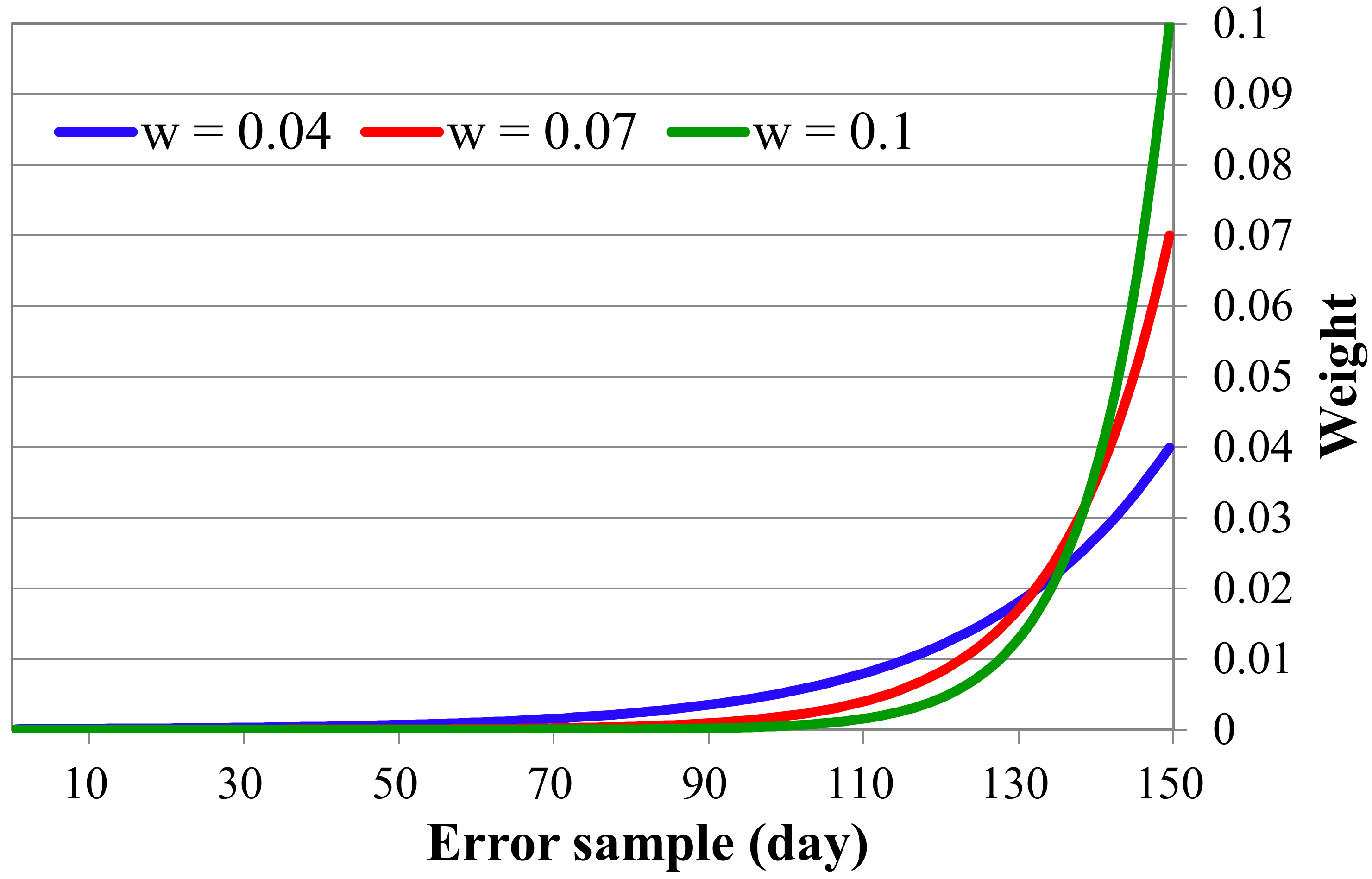

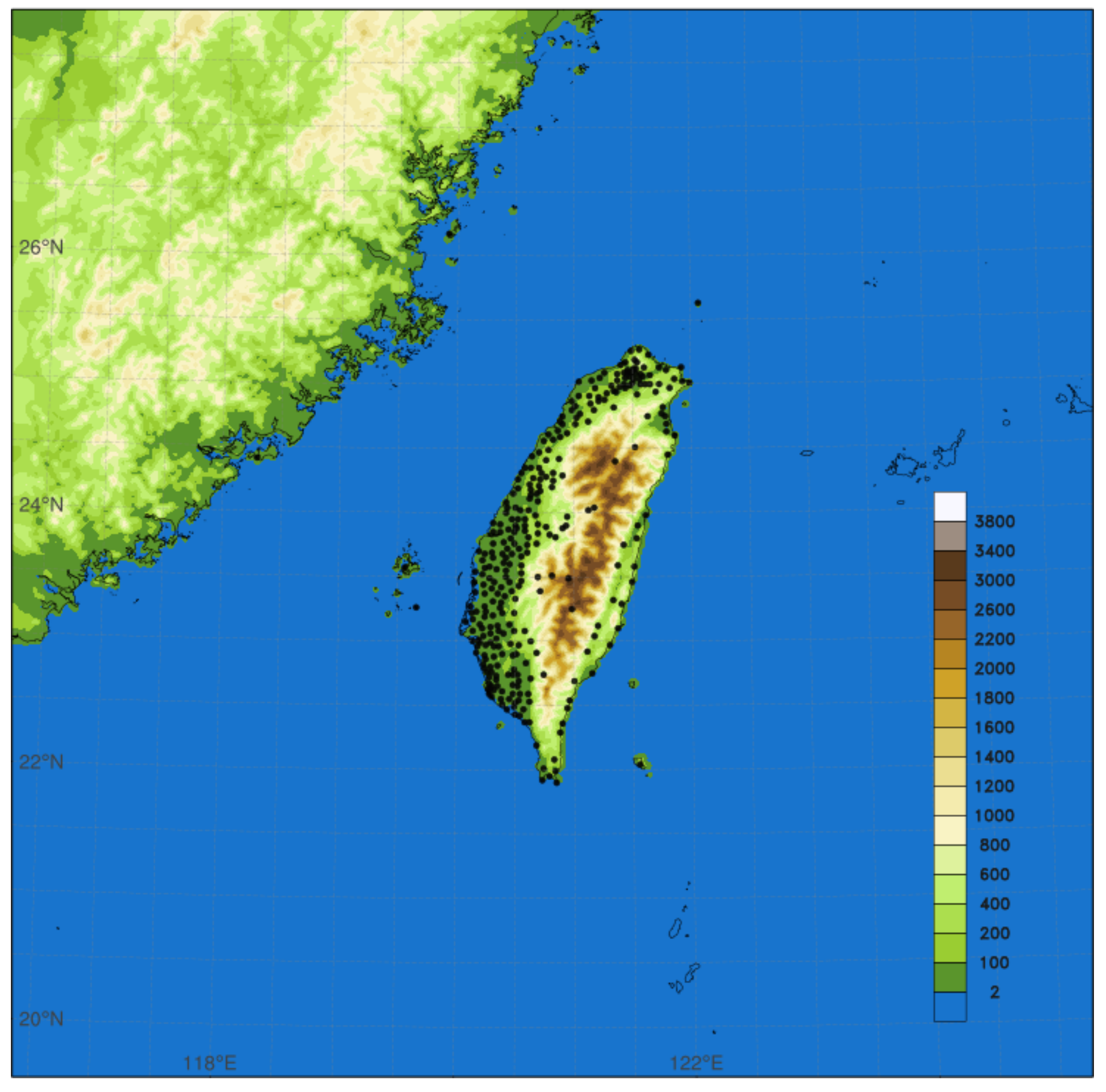
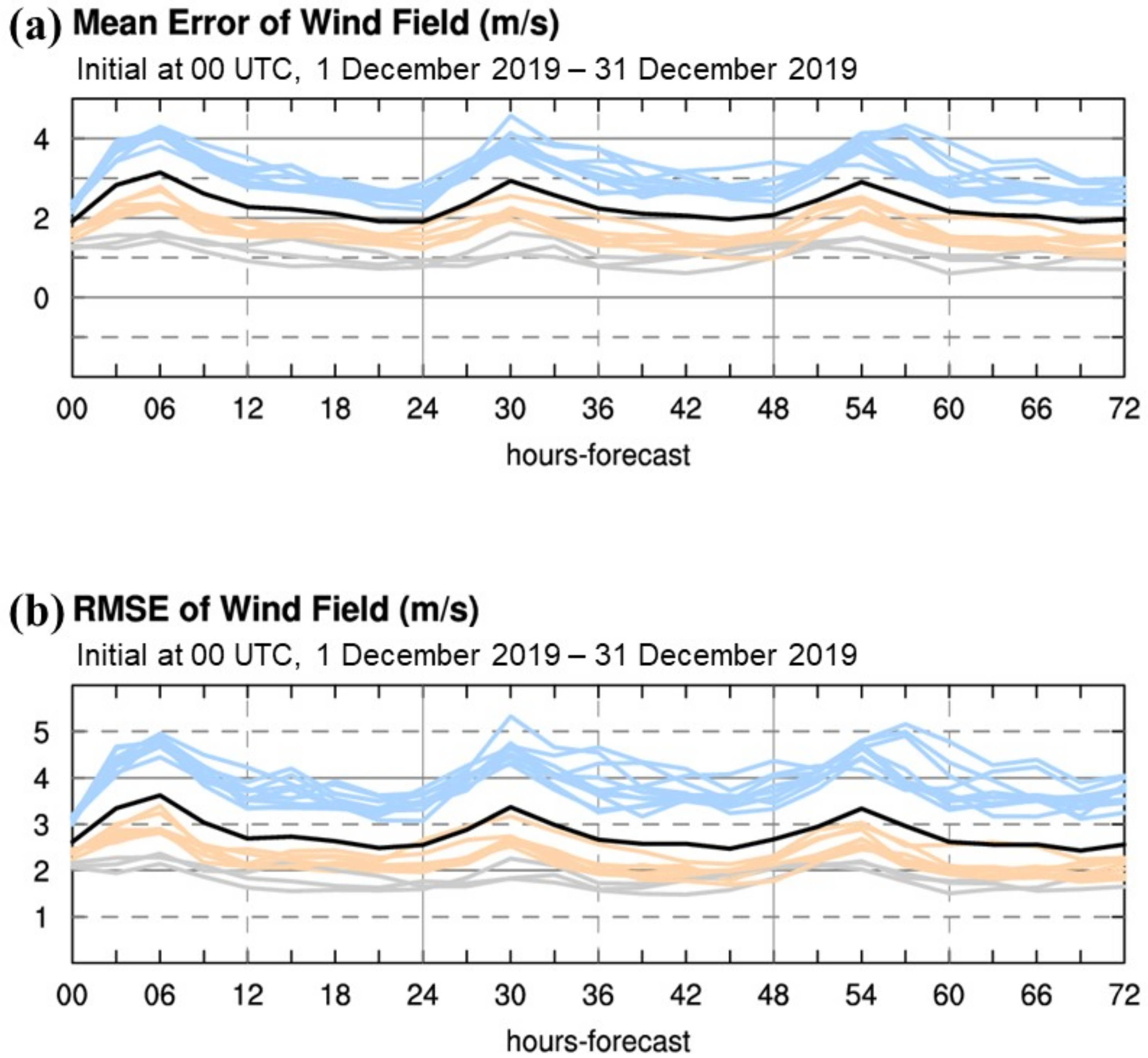
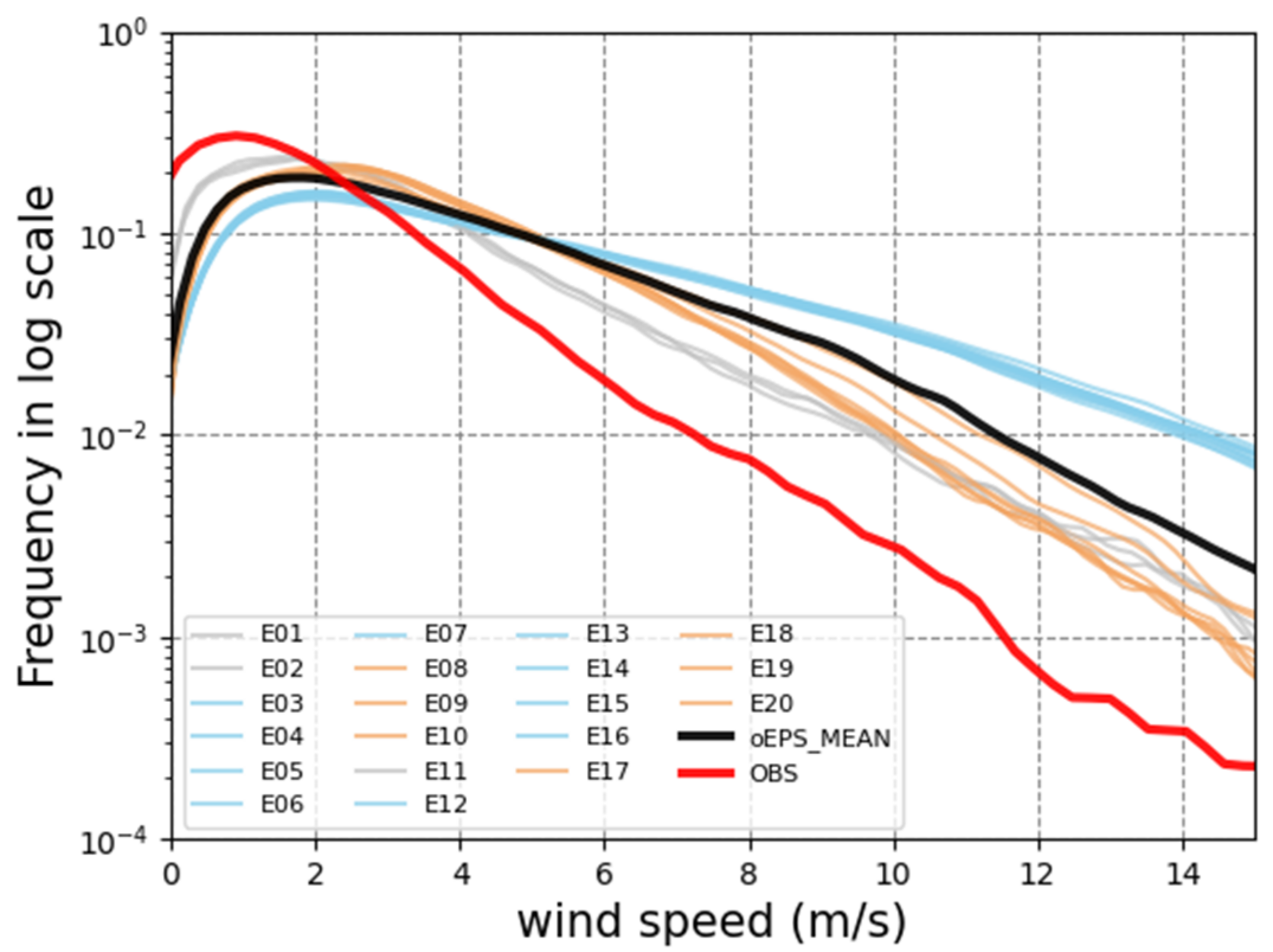
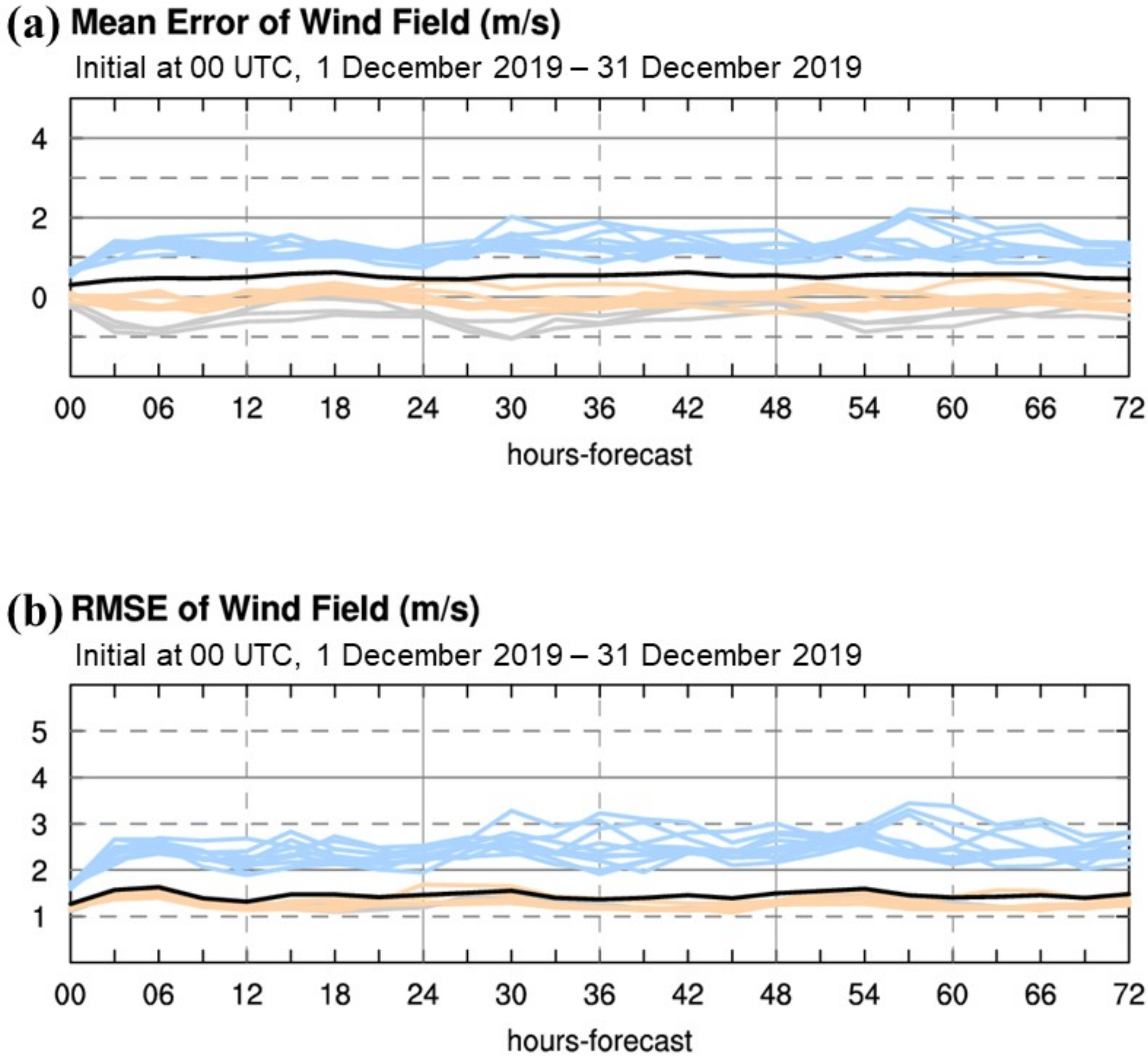
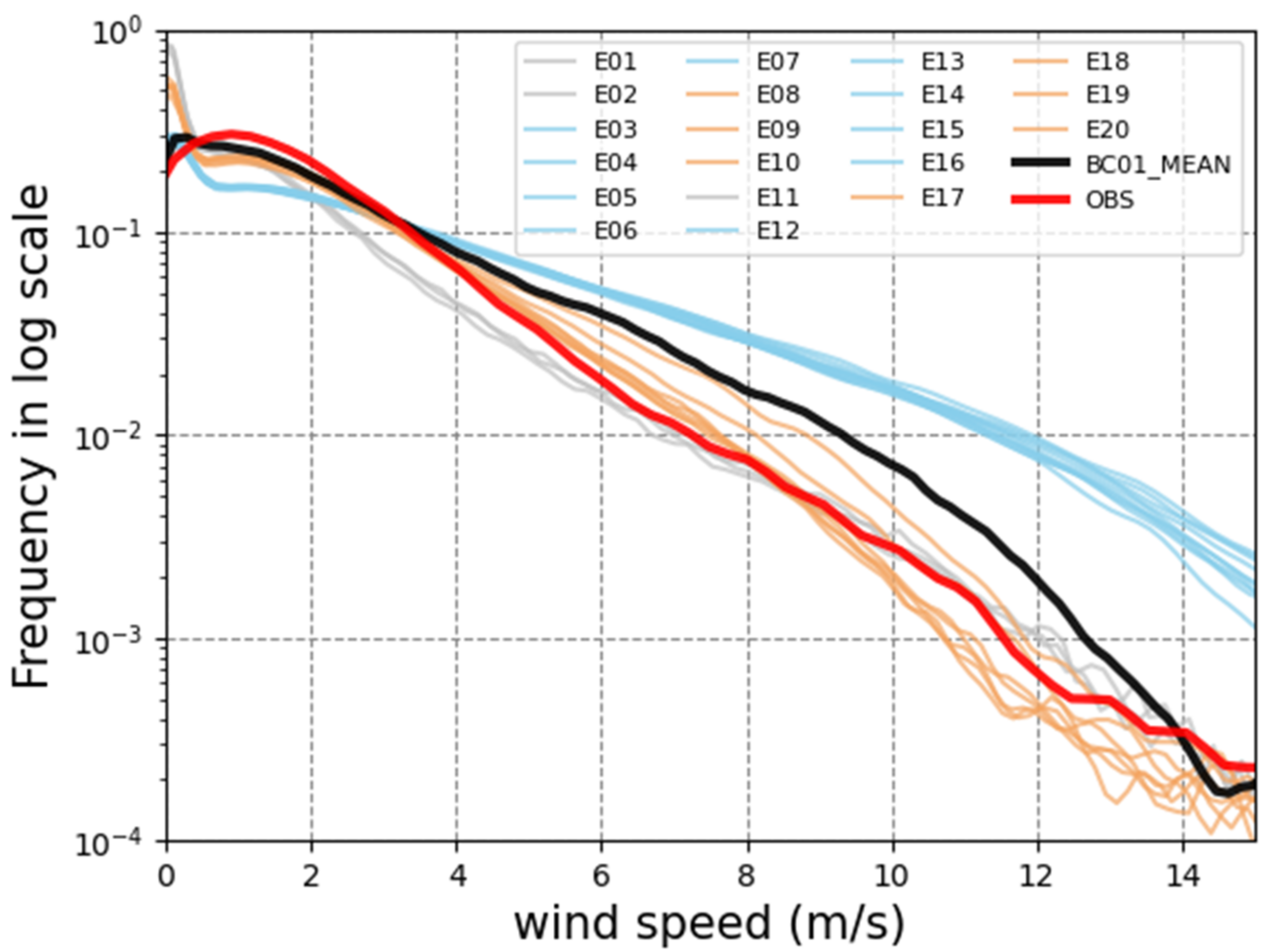
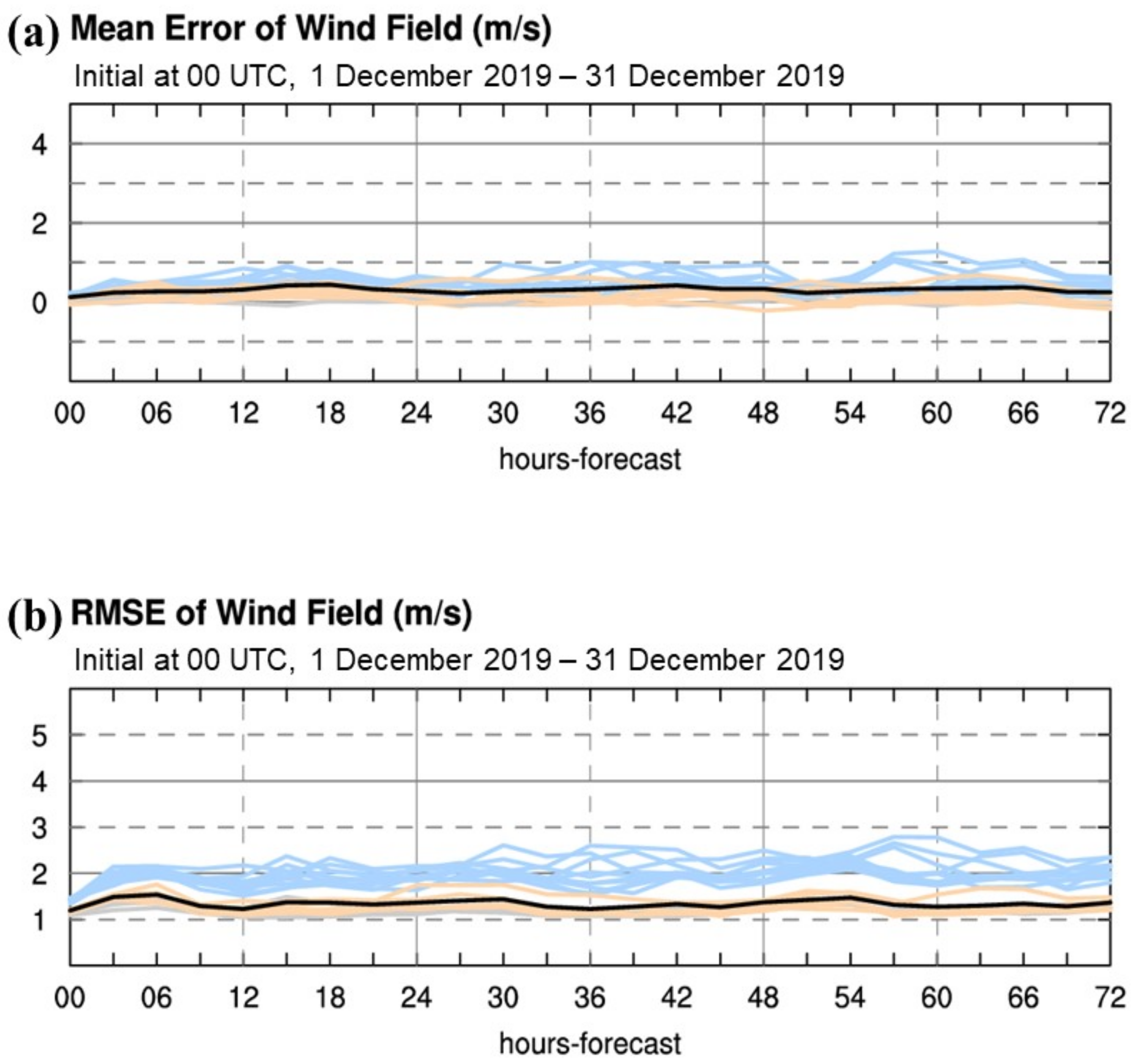
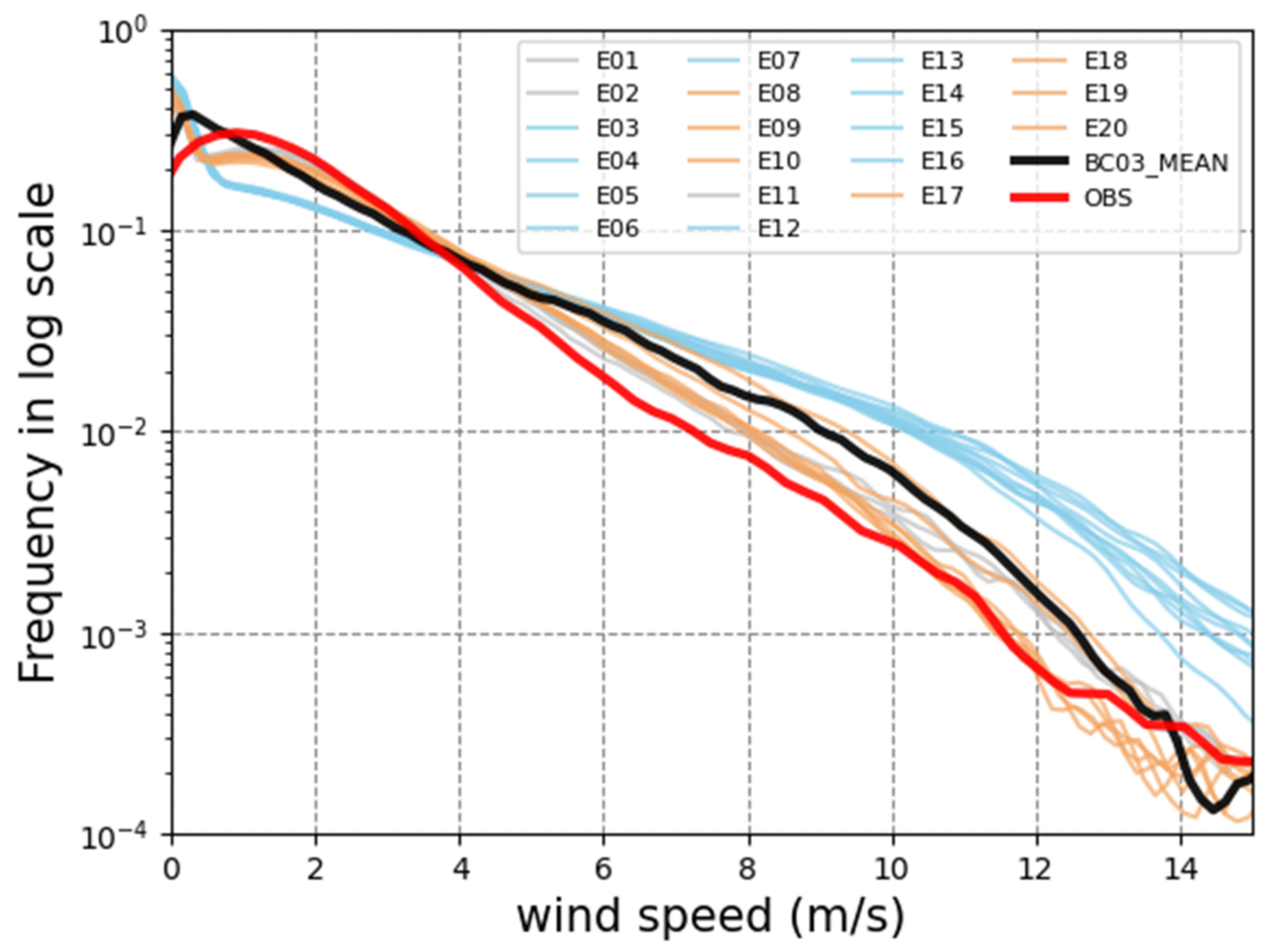

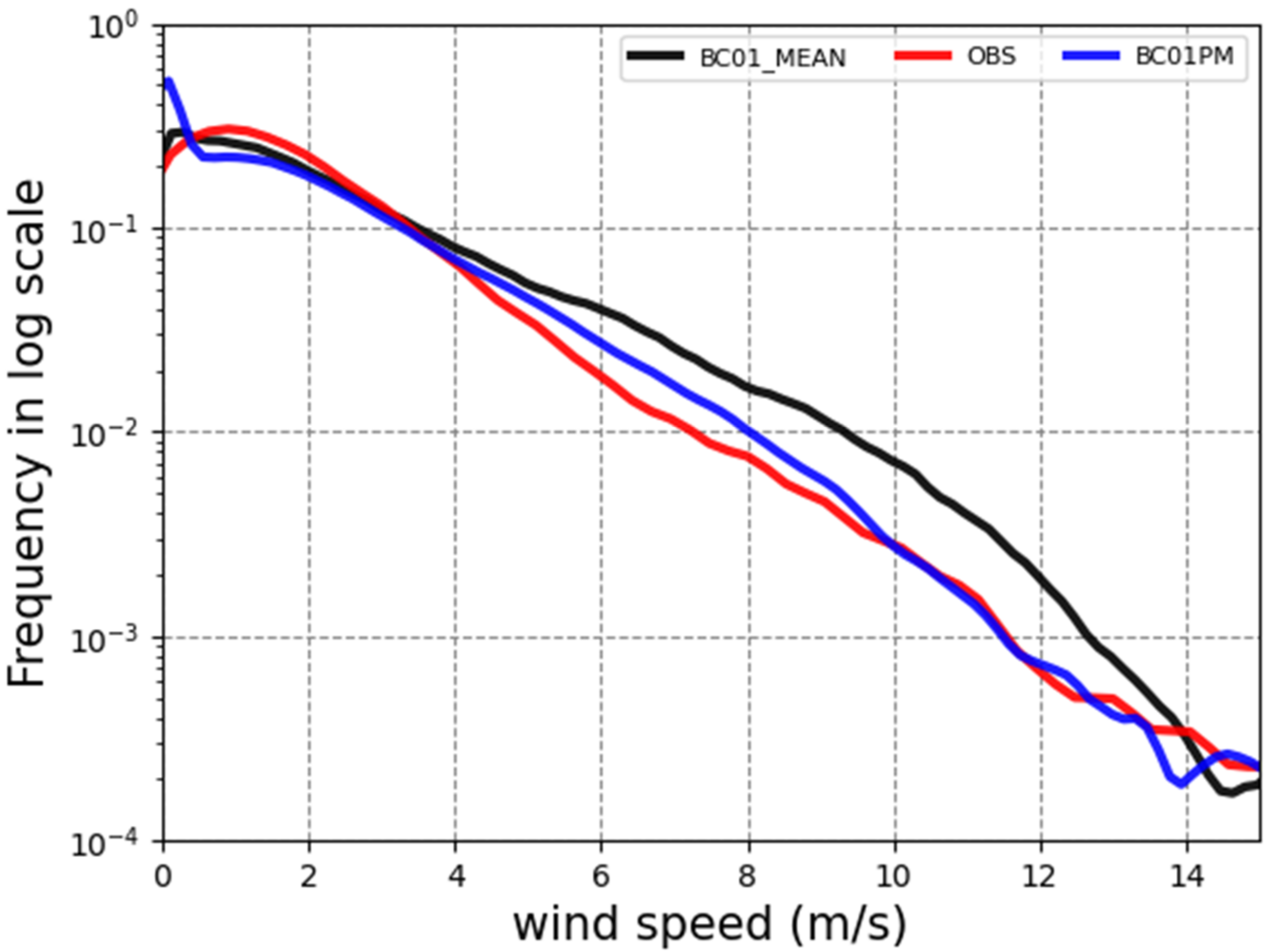
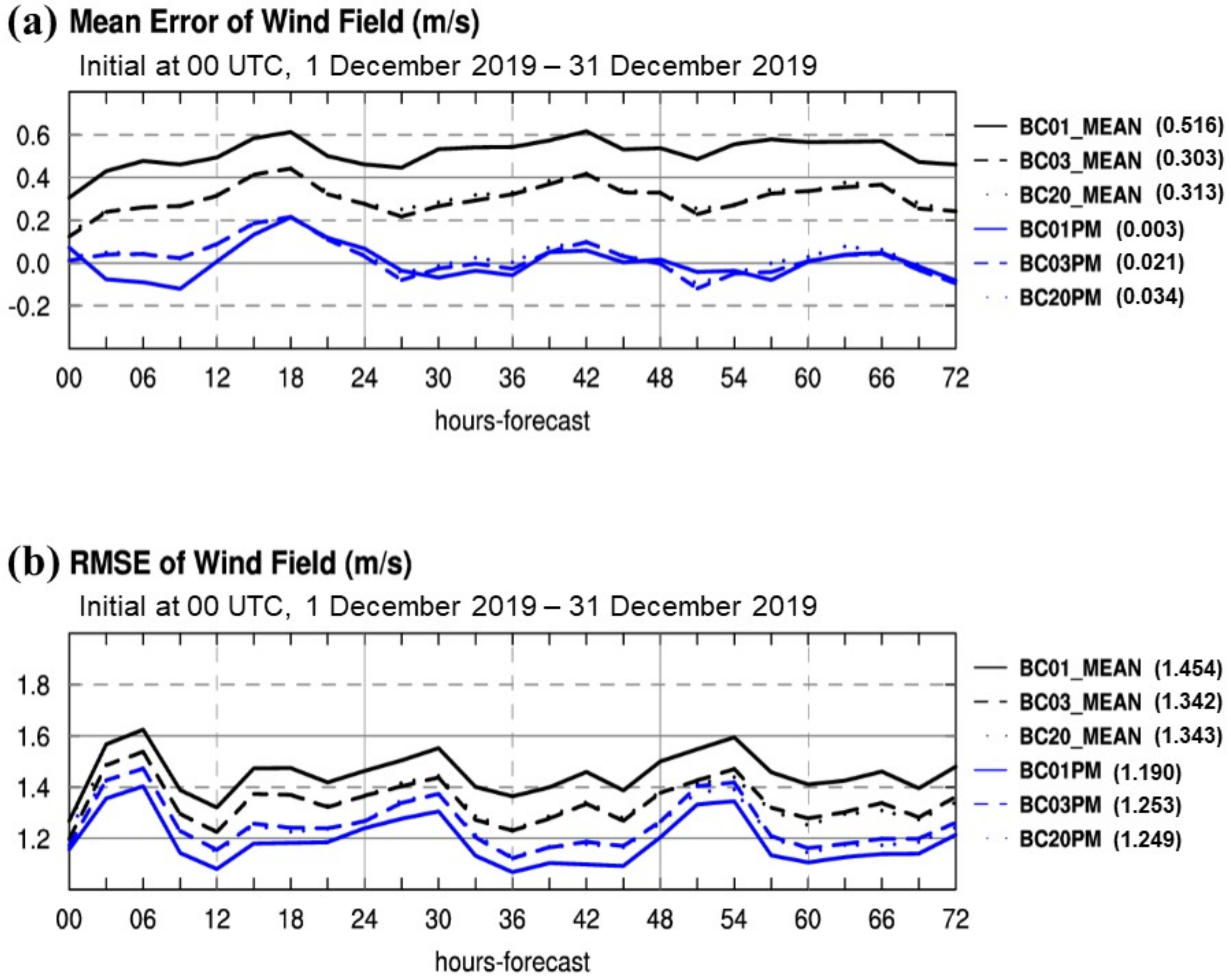
| Exp. | Bias Correction with Decaying Average Algorithm |
|---|---|
| oEPS | None |
| BC01 | System bias from a single model error of the original ensemble mean. |
| BC03 | System bias was represented by 3 model errors from each mean of PBL groups. |
| BC20 | System bias was represented by the independent member |
| BC01PM | Deterministic product from BC01 |
| BC03PM | Deterministic product from BC03 |
| BC20PM | Deterministic product from BC20 |
| oEPS | BC01 | BC03 | BC20 | |||||
|---|---|---|---|---|---|---|---|---|
| ME | RMSE | ME | RMSE | ME | RMSE | ME | RMSE | |
| MEAN | 2.29 | 2.80 | 0.52 | 1.45 | 0.30 | 1.34 | 0.31 | 1.34 |
| E01 | 1.13 | 1.87 | -0.46 | 1.27 | 0.17 | 1.21 | 0.14 | 1.19 |
| E02 | 1.01 | 1.80 | -0.55 | 1.29 | 0.07 | 1.20 | 0.14 | 1.20 |
| E11 | 1.13 | 1.89 | -0.46 | 1.28 | 0.18 | 1.24 | 0.16 | 1.22 |
| YSU_MEAN | 1.09 | 1.75 | -0.49 | 1.18 | 0.14 | 1.08 | 0.14 | 1.08 |
| E08 | 1.68 | 2.26 | -0.05 | 1.27 | 0.17 | 1.25 | 0.18 | 1.25 |
| E09 | 1.54 | 2.15 | -0.16 | 1.25 | 0.06 | 1.22 | 0.18 | 1.24 |
| E10 | 1.64 | 2.21 | -0.10 | 1.21 | 0.13 | 1.20 | 0.17 | 1.21 |
| E17 | 1.96 | 2.57 | 0.20 | 1.43 | 0.43 | 1.51 | 0.23 | 1.39 |
| E18 | 1.59 | 2.19 | -0.13 | 1.25 | 0.09 | 1.23 | 0.18 | 1.24 |
| E19 | 1.72 | 2.34 | -0.01 | 1.31 | 0.21 | 1.33 | 0.20 | 1.30 |
| E20 | 1.62 | 2.22 | -0.10 | 1.25 | 0.12 | 1.24 | 0.16 | 1.24 |
| MYNN2_MEAN | 1.68 | 2.16 | -0.05 | 1.11 | 0.17 | 1.11 | 0.19 | 1.11 |
| E03 | 3.10 | 3.89 | 1.23 | 2.46 | 0.47 | 2.01 | 0.45 | 1.99 |
| E04 | 3.14 | 3.96 | 1.27 | 2.52 | 0.49 | 2.07 | 0.46 | 2.02 |
| E05 | 2.93 | 3.72 | 1.08 | 2.33 | 0.33 | 1.92 | 0.43 | 1.95 |
| E06 | 3.10 | 3.92 | 1.24 | 2.49 | 0.47 | 2.05 | 0.48 | 2.04 |
| E07 | 3.27 | 4.07 | 1.38 | 2.59 | 0.59 | 2.11 | 0.48 | 2.04 |
| E12 | 3.05 | 3.82 | 1.18 | 2.39 | 0.42 | 1.94 | 0.46 | 1.95 |
| E13 | 3.15 | 3.92 | 1.28 | 2.47 | 0.50 | 2.00 | 0.46 | 1.96 |
| E14 | 2.97 | 3.77 | 1.12 | 2.36 | 0.36 | 1.93 | 0.45 | 1.96 |
| E15 | 3.08 | 3.84 | 1.21 | 2.39 | 0.43 | 1.94 | 0.44 | 1.94 |
| E16 | 3.01 | 3.74 | 1.14 | 2.29 | 0.36 | 1.85 | 0.41 | 1.86 |
| MYJ_MEAN | 3.08 | 3.74 | 1.21 | 2.26 | 0.44 | 1.80 | 0.45 | 1.80 |
| PM | – | – | 0.003 | 1.19 | 0.021 | 1.25 | 0.034 | 1.25 |
| Experiments | ME | RMSE | SPREAD |
|---|---|---|---|
| oEPS | 2.29 | 2.80 | 1.32 |
| BC01 | 0.52 | 1.45 | 1.15 |
| BC03 | 0.30 | 1.34 | 0.89 |
| BC20 | 0.31 | 1.34 | 0.86 |
Publisher’s Note: MDPI stays neutral with regard to jurisdictional claims in published maps and institutional affiliations. |
© 2021 by the authors. Licensee MDPI, Basel, Switzerland. This article is an open access article distributed under the terms and conditions of the Creative Commons Attribution (CC BY) license (https://creativecommons.org/licenses/by/4.0/).
Share and Cite
Tsai, C.-C.; Hong, J.-S.; Chang, P.-L.; Chen, Y.-R.; Su, Y.-J.; Li, C.-H. Application of Bias Correction to Improve WRF Ensemble Wind Speed Forecast. Atmosphere 2021, 12, 1688. https://doi.org/10.3390/atmos12121688
Tsai C-C, Hong J-S, Chang P-L, Chen Y-R, Su Y-J, Li C-H. Application of Bias Correction to Improve WRF Ensemble Wind Speed Forecast. Atmosphere. 2021; 12(12):1688. https://doi.org/10.3390/atmos12121688
Chicago/Turabian StyleTsai, Chin-Cheng, Jing-Shan Hong, Pao-Liang Chang, Yi-Ru Chen, Yi-Jui Su, and Chih-Hsin Li. 2021. "Application of Bias Correction to Improve WRF Ensemble Wind Speed Forecast" Atmosphere 12, no. 12: 1688. https://doi.org/10.3390/atmos12121688
APA StyleTsai, C.-C., Hong, J.-S., Chang, P.-L., Chen, Y.-R., Su, Y.-J., & Li, C.-H. (2021). Application of Bias Correction to Improve WRF Ensemble Wind Speed Forecast. Atmosphere, 12(12), 1688. https://doi.org/10.3390/atmos12121688






